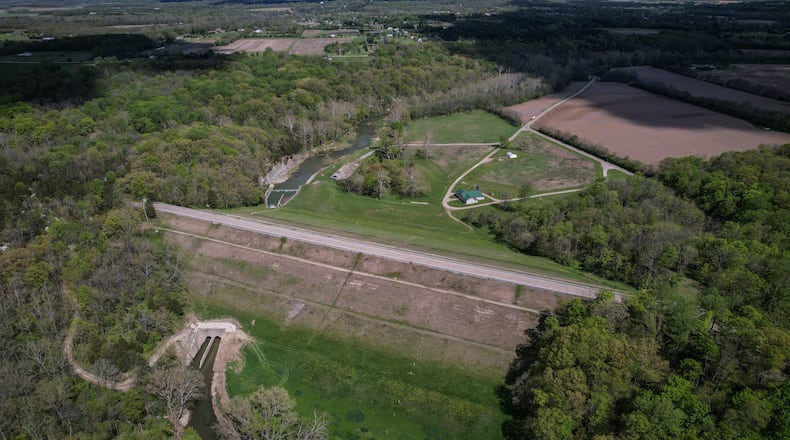Federal and state funding exists to push this project forward, and the conservancy district may have other financial choices to make following a series of assessments of property in the area for further work for the flood risk reduction system.
This may include a new capital assessment following the 2022 expiration of the district’s previous assessment, but it’s too soon to tell how that would impact a person’s property bill, Miami Conservancy District leaders said.
The district’s five dams — Englewood, Germantown, Huffman, Lockington and Taylorsville — and levee system protect roughly $7.3 billion in property. This includes six hospitals, more than 60 schools and colleges and more across five counties.
Increases in frequency, intensity of rainfall
Miami Conservancy District chief engineer Don O’Connor said the $10 million project would primarily focus on improving parts and pieces of the levee system: earth embankments, floodwalls and concrete revetments.
The biggest maintenance task for the area’s levees is mowing, O’Connor said. Workers also regularly inspect the levees, where they check the infrastructure for issues related to erosion and more.
Rainfall has significantly increased throughout the region over the past few decades, O’Connor said.
The Miami Conservancy District’s five dams have stored potential flood water 2,048 times since completion of the system in 1922. Prior to the 1990s, fewer than 200 storage events occurred per decade.
The number of storage events in each of the past three decades exceeded 200, and between 2010-2019 numbered more than 300. This is due to an average increase of nearly 5 inches in annual rain and snow.
Since this year began, the Great Miami River Watershed has seen 12.12 inches of precipitation – that’s 3.29 inches above normal average, according to the conservancy district.
March delivered, on average, 6.35 inches of precipitation. The highest rainfall amount – 9.01 inches – was recorded at the rain gauge located at Germantown dam on Twin Creek in Montgomery County, the district said.
“We have seen a steady climb,” he said. “Engineers all over the world are watching that and making sure that their systems can hold up these changes.”
Flood reduction ranked as a high priority
Great Miami River flood protection improvements were ranked as a regional priority project by the Dayton Region Priority Development and Advocacy Committee (PDAC) earlier this year.
PDAC is a committee of the Dayton Development Coalition that assists in establishing regional priorities for funding public projects.
Other government service projects that were ranked high in priority include the expansion of Dayton’s water quality laboratory and upgrades to the Dayton Wright Brothers airport terminal.
Lodor said the district has been working with government leaders like U.S. Rep. Mike Turner, R-Dayton, who recommended the project in his 2024 community project funding. The congressman is requesting $1.5 million for the project.
Other grant and loan opportunities are through the Army Corps of Engineers, the Federal Emergency Management Agency, as well as state funding opportunities.
New capital assessment in consideration
The district’s dam system was made between 1918 and 1922 to protect the Great Miami River valley in the wake of the 1913 flood, which killed more than 300 people. Community efforts after the flood led to the formation of the Miami Conservancy District.
Property owners who benefit from the protection of the flood risk reduction system are charged special assessments on their property bills. In 2022, the conservancy district collected $4.8 million through its maintenance assessment.
The conservancy district also charged a capital assessment that funded projects that went beyond maintenance. This assessment, which expired in 2022, collected roughly $1.6 million.
When the capital assessment expired last year, the district received approval from its board to increase its maintenance assessment by $1.6 million. Property owners saw no net increase to their property bills.
Later this year, Miami Conservancy District plans on requesting a new capital assessment, which would need to be approved by the district’s Board of Directors and the Conservancy Court.
It’s unclear how a new assessment would impact a property bill overall, as the district is also assessing its maintenance needs. Thus, the maintenance assessment collected from property owners could also change, Lodor said.
“We’re in the very early stages and still looking at what the needs are,” Lodor said.
The conservancy district is working with its board of seven consultants – many of whom work as geotechnical engineers or have worked in the U.S. Army Corps of Engineers – to determine what other work is needed at the district’s dams and the levy system.
“Because of the age of the system, more investment is needed to ensure the system remains functioning to reduce the risk of a dam or levee failure,” said consultant board chair John Smart.
About the Author


